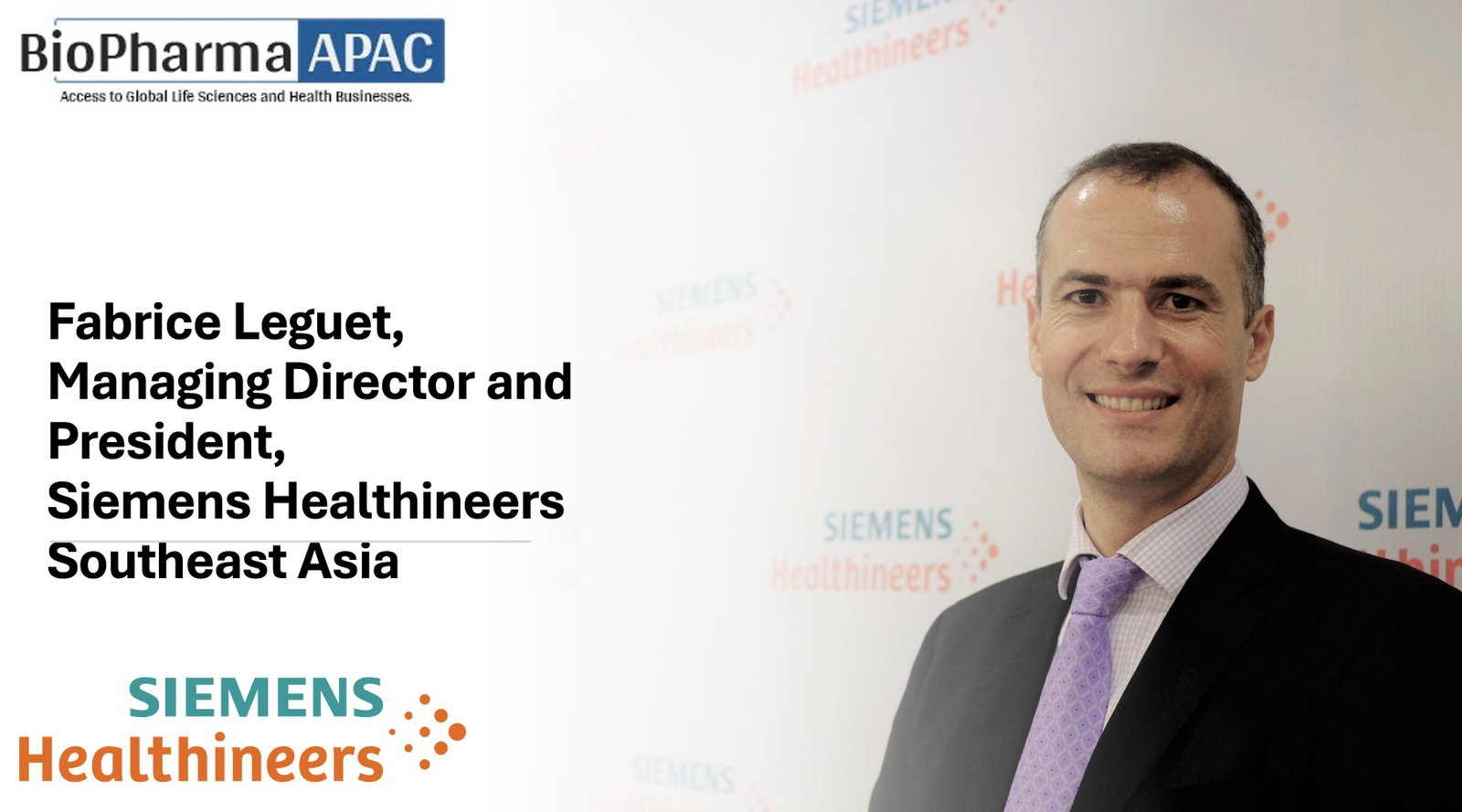Redefining Cancer Care in Southeast Asia: Siemens Healthineers’ Fabrice Leguet on Turning Awareness into Action
01 October 2025 | Wednesday | Interaction | By arcilla.fran@biopharmaapac.com

Cancer care in Southeast Asia stands at a critical crossroads. While awareness of early detection is high, the translation into meaningful action remains painfully inconsistent. Barriers of cost, access, and post-treatment understanding continue to widen the gap between knowledge and outcomes. In this exclusive conversation with BioPharma APAC, Fabrice Leguet,Managing Director, Southeast Asia and Head of Enterprise Services, Asia Pacific Japan, Siemens Healthineers, delves into the critical barriers patients face and the transformative potential of AI, digital innovation, and strategic partnerships. From free community screening initiatives to multi-country hub-and-spoke care models, he outlines Siemens Healthineers’ mission to make cancer care more accessible, affordable, and integrated for millions across the region.
Why do you think there is such a gap between people believing in early detection and actually going for screening?
The belief-action gap reveals a fundamental disconnect between cancer awareness and behavior change that varies dramatically across Southeast Asian markets.
Regional trends show patients aren't translating early detection awareness into intentional screening action. This pattern suggests three underlying issues. First, patients may not receive clear, specific guidance about cancer screening as a distinct health priority separate from general health maintenance. The higher routine screening numbers indicate screening happens, but often as an add-on rather than a deliberate step toward cancer prevention.
Thailand exemplifies this challenge with strong early detection belief but significantly fewer people taking specific cancer screening tests, with more undergoing screening as part of routine health checks. Indonesia shows an even starker trend, in an identical manner. This suggests that while awareness exists, the transition from general health maintenance to purposeful cancer prevention remains incomplete.
Second, risk perception remains abstract. Vietnam demonstrates this paradox most clearly with the region's highest personal risk perception, yet many still don't feel screening is necessary. Patients understand cancer as a population-level threat but struggle to translate statistical risk into personal urgency.
Third, healthcare complexity creates decision paralysis. Malaysia shows the region's highest knowledge gap about which screening tests are needed, while Philippines demonstrates a significant disconnect between early detection awareness and perceived screening necessity.
The psychological challenge is significant: cancer screening requires healthy people to actively seek potentially distressing information about future disease risk. Unlike symptomatic care where patients seek relief from current discomfort, screening demands action based on hypothetical future benefit.
Addressing these challenges requires targeted patient engagement strategies that convert general awareness into specific action. Our partnership with Siloam Hospitals Group, Indonesia’s largest private cancer care provider, demonstrates how systematic approaches can bridge this gap effectively. Together, we launched a free-of-charge screening program in 2023 targeting 50,000 women, particularly in rural areas with limited access to screening services.
The program recognizes that breast cancer screening remains highly inaccessible due to limited hospital facilities and the lack of publicly funded, nationwide programs. By strategically identifying areas with high cancer burdens, eight Siloam screening centers have successfully screened 32,000 women across 116 villages.
The partnership leverages AI-powered mammography reading tools to address radiologist shortages, providing critical second opinions that reduce workload while maintaining quality. When abnormalities are detected, the integrated Siemens Healthineers ecosystem enables seamless progression through further evaluation, therapy planning, and follow-up care, ensuring patients don't fall through gaps in the care continuum.
How can cost and access barriers in cancer care be reduced across Southeast Asia?
Patient perceptions of cost and access barriers reveal significant regional variations that require tailored intervention strategies, though perceptions may not always align with actual system capabilities.
Regional patterns show dramatic differences in cost concerns, with Singaporeans citing expense as a major barrier while Indonesians show lower cost sensitivity. However, accessibility perceptions reveal different challenges, with both Indonesia and the Philippines showing limited treatment accessibility perceptions, suggesting systemic challenges beyond affordability.
Addressing these varied barriers requires innovative solutions and delivery models adapted to local contexts. As the market in Southeast Asia continues to develop and adjust to the unmet needs for healthcare across the region, we see unique business models being developed to bring access to oncology services to patients in Malaysia and Indonesia. This approach is demonstrated through our Value Partnership with Curie Oncology, which is developing a Southeast Asia-wide network of locations and partners strongly connected with each other, and leveraging the deep clinical and management experience of a group of oncology experts, both through on-site support and remote interactions and the access to the best technology and AI. This enables us to bring the highest quality of care closer to patients, transcending distance and differences of maturity between healthcare systems.
For geographically dispersed populations, network-based solutions can overcome access challenges while achieving economies of scale and maintaining reasonable costs. Our partnership with the HMI Group is another example whereby centers of excellence have been set up to serve as accessible hubs of experts for more distant “spoke” locations. The role of these hubs are: to develop and maintain a high-level of specialized expertise, to define standard care protocols, to ensure consistent access to the latest fit-for-purpose technology, to set up a common digital backbone, and to make all of this available to other geographies - in this particular case across Singapore and Malaysia. Beyond our technology, this multi-country model has been also leveraging our advisory capabilities in setting up oncology programs as well as driving operational performance, for instance to optimize equipment utilization and patient workflows across diverse clinical environments.
Scale and standardization also enable broader affordability. Our partnership in Thailand with Principal Capital Public Company Limited (PRINC) also demonstrates scalable affordability through standardized care delivery models. We supported the PRINC Group through a feasibility study aimed at identifying the most critical sites across the hospital network for the ramp-up of oncology services, balancing population needs with capital requirements and sustainability of investment.
Where private solutions alone are insufficient, public-private collaboration becomes essential. Siemens Healthineers has been actively involved in advising several Ministries of Health through workshops to advocate for healthcare reimbursement and medical device regulations in the country. For example, our advisory role in Vietnam's oncology strategy development shows how private sector efficiency can complement public sector planning.
However, addressing cost barriers also requires recognizing that patient perceptions play a factor in care-seeking behavior. Even where affordable options exist, poor communication about available coverage options can maintain barriers to care access, making transparent communication about costs and coverage as important as the financial models themselves.
Why is post-treatment care still poorly understood, and how can it be improved?
Post-treatment understanding shows remarkably consistent gaps across the region, suggesting structural communication challenges rather than resource limitations.
Regional findings reveal that while the majority know ongoing care exists, actual understanding remains limited, with significant portions across markets reporting they do not understand what survivorship and follow-up care involves.
This consistency across different healthcare maturity levels, from Singapore's relatively advanced system to Indonesia's developing infrastructure, indicates the challenge may stem from care transition design rather than resource availability. The challenge lies in healthcare systems historically optimized for acute care episodes rather than longitudinal management. Patients successfully completing treatment often experience unclear transitions where ongoing care responsibility shifts between providers, creating uncertainty about needs and appropriate next steps.
However, leading Centers of Excellence are demonstrating how systematic approaches can address these gaps effectively. Rather than treating survivorship as an afterthought, effective Centers of Excellence integrate survivorship planning throughout the treatment journey. Digital patient outcomes management solutions enable real-time symptom reporting during outpatient chemotherapy, allowing care teams to identify and address concerns proactively. Studies demonstrate that patients who self-report outcomes while receiving treatment experience better health-related quality of life, reduced hospitalization rates, and improved quality-adjusted survival.
These centers also deploy clinical decision support tools that don't replace physician authority but rather classify and present relevant information, enabling specialists to make more informed decisions about long-term care planning. Through automated prioritization systems, care teams can intervene with patients showing critical needs while systematically preparing comprehensive survivorship care plans that clearly define ongoing responsibilities and expectations across different care phases.
Building on these proven approaches, broader improvement requires three systematic changes. First, survivorship planning must begin during diagnosis rather than after treatment completion. Second, care teams need standardized protocols that clearly define roles and responsibilities throughout the cancer journey. Third, patients need accessible, ongoing education about what to expect during different phases of care, transforming survivorship from a poorly understood concept into a well-planned continuation of comprehensive cancer care.
How realistic is the “one-stop” cancer care model for the region?
Patient confidence in one-stop cancer care models varies significantly, with Singapore showing the highest confidence and Indonesia showing the lowest, but implementation success depends more on systematic execution than initial patient confidence levels.
Patient confidence correlates with current perceived healthcare experiences. Singapore and Thailand, with the highest screening participation rates, show greatest confidence in comprehensive care solutions. Conversely, Indonesia, where treatment accessibility perceptions are limited and screening rates remain low, shows corresponding skepticism.
"One-stop" implementation must adapt to local healthcare contexts while building patient confidence through demonstrated results. In Singapore, comprehensive tertiary centers leveraging advanced technology make sense given existing infrastructure. In Indonesia, a hub-and-spoke model offers a more practical approach to improve access for patients in rural communities. This model establishes comprehensive cancer centers in major urban areas as "hubs" while connecting smaller satellite facilities in rural regions as "spokes," maintaining seamless digital referral pathways and telemedicine capabilities.
The hub-and-spoke approach allows rural patients to receive screening and high-quality care locally. While the most complex cases may seamlessly be referred to specialized centers, digital connectivity and clear protocols ensure that the expertise from urban centers can support rural facilities along the patient pathway through remote consultations, remote-scanning and diagnostics and even remote treatment planning.
This model builds patient confidence gradually by demonstrating consistent quality across the network while making specialized cancer care accessible without requiring patients to travel long distances for routine services. It enables us to overcome what remains challenge #1 in many developing markets: the availability of qualified healthcare professionals away from metropolitan centers.
In this context, our Value Partnership approaches demonstrate practical implementation across the region, adapting standardized clinical pathways to different regulatory environments and resource constraints. These partnerships show how standardized Centers of Excellence frameworks can be tailored to local healthcare needs while maintaining consistent quality standards across Southeast Asia's diverse regulatory and economic landscape.
Geographic realities mean "one-stop" may look different across markets: comprehensive facilities in urban centers and connected networks in rural areas, but the principle of eliminating the patient navigation burden remains consistent.
The key insight is that patient confidence grows through demonstrated results. Markets showing skepticism today can develop confidence as integrated models prove their effectiveness in improving patient outcomes and experiences.
What role can AI and digital innovation play without replacing clinicians?
Regional patient attitudes reveal sophisticated expectations for AI as clinical support rather than replacement, with acceptance patterns varying significantly across markets and application types.
Thailand shows highest reliance on physician endorsement for building technology confidence, combined with lower dependence on government regulatory approval as a confidence-building factor, suggesting trust in medical authority over a need for regulatory oversight. Philippines demonstrates the highest expectations for advanced technology integration specifically in recurrence detection.
Malaysia shows strong belief that AI should complement rather than replace human expertise, with significant acceptance of AI use provided patients are informed. Singapore presents similar patterns with strong preference for AI as complement to human expertise and acceptance contingent on patient transparency.
These regional preferences for physician-guided AI implementation are being realized through practical deployments across the region. Successful case studies of collaboration illustrate practical AI implementation across diverse healthcare environments. In Indonesia, Mayapada Healthcare's digital transformation showcases integrated AI workflows with syngo.via from Siemens Healthineers, that enables oncologists to compare images from our PET/CT scanner to accurately track the disease progression over time. Siemens Healthineers has also deployed Organs-RT, an AI-based auto contouring solution at National Cancer Center Singapore that provides radiation therapists with automatic contouring of organs at risk, which helps with their radiation therapy planning for the patient.
These implementations align with broader regional digital transformation efforts, where AI-powered imaging, automated clinical workflows, and telemedicine networks expand access to specialized care. Our recent MoU signed with Phuong Dong General Hospital exemplifies this approach, deploying AI-powered imaging integrated with photon-counting CT and advanced MRI systems that provide Vietnamese clinicians with enhanced diagnostic capabilities while addressing the region's 8.6% annual digital healthcare growth trajectory.
The goal is symbiotic enhancement where technology handles routine monitoring and data analysis while clinicians focus on personalized care, complex decision-making, and patient relationships. Success requires transparent communication about AI's supporting role and consistent physician oversight of all clinical decisions.
What are the top priorities to bridge gaps in the cancer care journey?
The transformation of cancer care in Southeast Asia requires addressing fundamental structural challenges while leveraging available opportunities. Insights from our first ASEAN Oncology Summit at Hospital Management Asia 2025 reinforce several critical priorities that have emerged from our regional experience.
First, accelerating healthcare system specialization is essential. While Southeast Asia's healthcare systems have evolved impressively in recent years, the region must now focus on developing specialized, multi-disciplinary comprehensive cancer care centers that provide seamless patient experiences. These centers eliminate the current fragmentation where patients endure referrals between institutions with risk of critical information loss.
Second, achieving economies of scale through large networks of cancer care delivery. Hub-and-spoke models can ensure accessibility, affordability, and quality by augmenting local staff skills and productivity with highly specialized remote support and AI-enabled solutions. This approach makes state-of-the-art knowledge and personalized procedures available locally, reducing patient stress and treatment delays.
Third, establishing deep expertise partnerships between stakeholders. The complexity of modern cancer care requires capex-heavy infrastructure and rapidly evolving domain knowledge that can only be managed through long-term, goal-oriented collaborations where each partner contributes unique strengths.
The foundation for transformation already exists: the needed technology, connected care digital platforms, AI capabilities, and clinical pathway knowledge are readily available. Combined with significant private equity investment interest across the region and cancer specific government programs, all ingredients are present to make quality cancer care accessible to every patient across Southeast Asia.
Most Read
- How Health Systems Are Reshaping Drug Adoption, Partner Models, and Market Access in 2026
- Top 25 Biotech Innovations Redefining Health And Planet In 2025
- The New AI Gold Rush: Western Pharma’s Billion-Dollar Bet on Chinese Biotech
- Top 25 Biotech & Biopharma Leaders in Sustainable Innovation, 2025
- China’s Biopharma Dealmaking Surges in H1 2025, Driven by Record Licensing and Oncology Focus
- Chikungunya in China: How a “Forgotten” Arbovirus Found the Perfect Storm
- How Innovation Gaps in Biopharma Raise New Safety Concerns
- Smart Implants and the Future of Musculoskeletal Injury Treatment
- How Ethical Gaps in Psychiatry Could Undermine Biopharma Progress
- The Evolving Landscape of Women’s Health Innovation in the Asia-Pacific
- Using NLP-Driven Decision Support in Emergency Health Assistance
- Taiwan Steps Into the Global Spotlight With a New Cancer Therapy
- The Role of Unique Device Identification (UDI) in Tracing Medical Device Safety
- The Importance of a Patient’s Mental Health During Clinical Trials
Bio Jobs
- The State of Biotech and Life Science Jobs in Asia Pacific – 2025
- Avantor’s New CEO Ligner Aims to Unlock Global Potential and Deliver Shareholder Value
- AstraZeneca Commits $50 Billion to U.S. Expansion by 2030 in Biggest-Ever Global Investment
- Thermo Fisher, SAMRC, and South Africa’s Department of Science and Innovation Launch CATIR to Nurture Next-Gen Scientists
- Cube Biotech Appoints Former Sartorius CEO Dr. Joachim Kreuzburg to Board of Directors
- FDA’s AI Transition Marks a Turning Point in Drug Review: Industry Faces Pressure to Adapt Amid 20% Workforce Cut
- WuXi XDC Completes Mechanical Build of Singapore Bioconjugate Manufacturing Hub
News
Editor Picks











